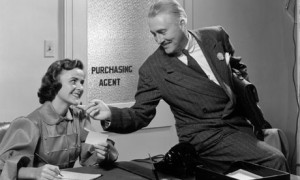One of the most memorable seminars I ever attended as a student was in a political philosophy course, in which one week covered debates about wealth stratification in ideal and real societies. We students were to submit short position papers about what we thought would be the ideal ratio of income inequality in a society. That is, how much gap would be necessary to inspire innovation, excellence, and risk-taking, while also not being so large that it would lead to societal breakdown, unjustifiable poverty, dangerous concentrations of power, or, at worst, armed revolution.[caption id=“attachment_26974” align=“alignright” width=“300”] “No, no, dear. It’s only 20 times more than yours.”[/caption]As I recall it, the most left-wing students in the class were in the 10-to-1 range (200K income vs. 20 K income), and the more libertarian students rejected the very notion of an ideal ratio (“let the market do its thing, and let the people revolt if necessary”). There were lots of folks in the middle (20-to-1 or even 100-to-1).The real ratios of income inequality in the U.S. have become basically unimaginable since then (as in, I have real trouble imagining the fact that the one Walton family has as much wealth as the bottom 35-40% of our country). Discussion of these ratios has recently focused instead on individual companies. The data is easier to imagine and is, I think, more meaningful, since all the members of a company are, in some sense, working toward common goals and have very clear rewards for working toward them together.Yesterday Bloomberg news put out an excellent story and data infographic of current CEO-to-worker pay ratios. (Fortune did a smaller graphic last year.) In short, the ratio has grown by 1,000% since 1950. Many of us already knew that. What I did not know was that it has even grown since the financial crisis and Great Recession -- up 20% since 2009.The attention-grabbers are the top ratios, with J. C. Penney winning the inequality award at 1,795-to-1. (That’s one loaf of bread vs. the Empire State Building, to help you imagine it.) The story profiles a sales employee as contrasted to the ousted C.E.O.But it’s the overall picture that is worth pondering. Most real people do in fact retain drive for innovation, excellence, and risk-taking with much lower ratios than companies currently have. I have no doubt some of CostCo’s employees are working hard to innovate and excel, even though they only have the “low” ratio of about 50-to-1.For those who often pine for the 1950’s, the relatively low income inequality of that era should be remembered as a central aspect of overall stability. And the unprecedented income equality in our own era should be considered a bellwether of further instability.
“No, no, dear. It’s only 20 times more than yours.”[/caption]As I recall it, the most left-wing students in the class were in the 10-to-1 range (200K income vs. 20 K income), and the more libertarian students rejected the very notion of an ideal ratio (“let the market do its thing, and let the people revolt if necessary”). There were lots of folks in the middle (20-to-1 or even 100-to-1).The real ratios of income inequality in the U.S. have become basically unimaginable since then (as in, I have real trouble imagining the fact that the one Walton family has as much wealth as the bottom 35-40% of our country). Discussion of these ratios has recently focused instead on individual companies. The data is easier to imagine and is, I think, more meaningful, since all the members of a company are, in some sense, working toward common goals and have very clear rewards for working toward them together.Yesterday Bloomberg news put out an excellent story and data infographic of current CEO-to-worker pay ratios. (Fortune did a smaller graphic last year.) In short, the ratio has grown by 1,000% since 1950. Many of us already knew that. What I did not know was that it has even grown since the financial crisis and Great Recession -- up 20% since 2009.The attention-grabbers are the top ratios, with J. C. Penney winning the inequality award at 1,795-to-1. (That’s one loaf of bread vs. the Empire State Building, to help you imagine it.) The story profiles a sales employee as contrasted to the ousted C.E.O.But it’s the overall picture that is worth pondering. Most real people do in fact retain drive for innovation, excellence, and risk-taking with much lower ratios than companies currently have. I have no doubt some of CostCo’s employees are working hard to innovate and excel, even though they only have the “low” ratio of about 50-to-1.For those who often pine for the 1950’s, the relatively low income inequality of that era should be remembered as a central aspect of overall stability. And the unprecedented income equality in our own era should be considered a bellwether of further instability.

